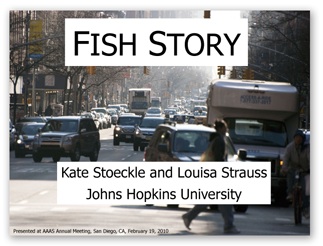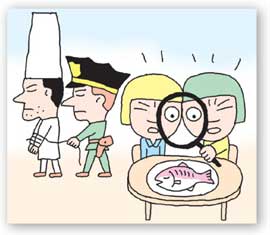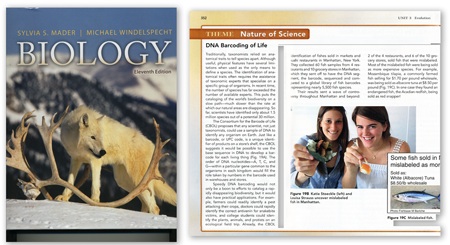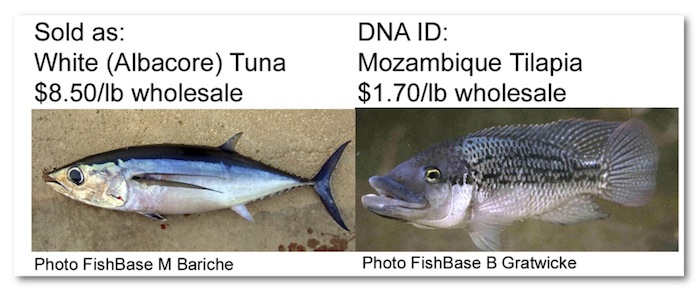NYCFish (“Sushigate”): high school students discover one-quarter of fish sold in their NYC neighborhood is mislabeled

News report by students Kate Stoeckle and Louisa Strauss
Dubbed “Sushi-gate”, their investigation drew wide and continuing interest
The New York Times
August 21, 2008, page 1

Time Magazine

Invited presentation at AAAS annual meeting, San Diego, CA, Feb 2010
download PPTX

Chosun Ilbo (Korean Daily News) circulation 2.2 million

Featured in McGraw-Hill Biology, 11th edition, 2013
Mislabelings were as more expensive or more desirable fish
For example:

Student study helped spawn further investigations
- The Boston Globe, October 23, 2011
- Hanner R et al 2011 Mitochondrial DNA
- Consumer Reports, December 2011
- Oceana Report, June 2012
In October 2011, US FDA officially adopted DNA barcoding for detection of seafood fraud
https://www.fda.gov/Food/FoodSafety/Product-SpecificInformation/Seafood/DNAspeciation/default.htm
More on “Sushi-gate”
Among 60 items tested:
- Nile Perch (Africa), Lavender Jobfish (SE Asia), Slender Pinjalo (SE Asia), and Acadian Redfish (N Atlantic) sold as “Red Snapper“
- Mozambique Tilapia sold as “White Tuna”
- Smelt Roe sold as “Flying Fish Roe”
- Caribbean Spotted Goatfish sold as “Mediterranean Red Mullet”
- White Bass (farmed freshwater fish) sold as “Sea Bass”
Mislabeled items sold in 6 of 10 grocery stores/fish markets and 2 of 3 restaurants
In a NY Times sequel story, chefs claimed supreme expertise, followed by a Op-Ed “Fish or Foul” highlighting fallible judgment of experts.
Research article reporting NYCFish findings: Wong EHK, Hanner RH, 2008, DNA barcoding detects market substitution in North American seafood. Food Res International 41:828-837.
About the Bar Code of Life site
This web site is an outgrowth of
the Taxonomy, DNA, and Barcode of Life meeting held at Banbury
Center, Cold Spring Harbor Laboratory, September 9-12, 2003.
It is managed by Mark Stoeckle at the Program
for the Human Environment (PHE) at The Rockefeller University.
Contact: mark.stoeckle@rockefeller.edu
About the Program
for the Human Environment
The involvement of the Program for the Human Environment in DNA
barcoding dates to Jesse Ausubel's attendance in February 2002
at a conference in Nova Scotia organized by the Canadian Center
for Marine Biodiversity. At the conference, Paul Hebert
presented for the first time his concept of large-scale DNA
barcoding for species identification. Impressed by the
potential for this technology to address difficult challenges
in the Census of Marine Life, Jesse agreed with Paul on
encouraging a conference to explore the contribution
taxonomy and DNA could make to the Census as well as other large-scale
terrestrial efforts. In his capacity as a Program Director of
the Sloan Foundation, Jesse turned to the Banbury Conference
Center of Cold Spring Harbor Laboratory, whose leader Jan
Witkowski prepared a strong proposal to explore both the
scientific reliability of barcoding and the processes that
might bring it to broad application. Concurrently, PHE
researcher Mark Stoeckle began to work with the Hebert lab on
analytic studies of barcoding in birds. Our involvement in
barcoding now takes 3 forms: assisting the organizational
development of the Consortium for the Barcode of Life and the
Barcode of Life Initiative; contributing to the scientific
development of the field, especially by studies in birds, and
contributing to public understanding of the science and
technology of barcoding and its applications through improved
visualization techniques and preparation of brochures and other
broadly accessible means, including this website. While the
Sloan Foundation continues to support CBOL through a grant to
the Smithsonian Institution, it does not provide financial
support for barcoding research itself or support to the PHE for
its research in this field.


